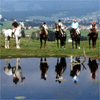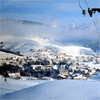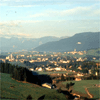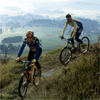|
|
|
Asiago & 7 Comuni Guide Italy
|
 |
 |
 |
 |
|
|
|
|
Directories of Web Sites:
Asiago & 7 Comuni Italy
Asiago & 7 Comuni Hotels
Asiago & 7 comuni Guide
The orographic conformation of the Altopiano enabled the development of more than 300 km of cross-country ski runs.
Many international athletes train here for the competitions, on that same snow that, in 1996, housed the Jr. Northern Skiing World Championship for the second time.
While on one side of the mountain the territory spontaneously offers its lanscape for cross-country skiing, on the other side of it downhill skiing is possible.
Here, the local operators were able to create other opportunities such as wonderful ski runs with different levels of difficulty.
All of this is obviously matched by marvellous extensive panoramas where the ski-lifts fit in perfectly.
The covering of artificial snow guarantees a white mantle in case of poor snowfalls.
Ski instructors are at your disposal and the bars and restaurants of the refuges are always ready to give refreshment and are situated next to the ski runs.
Horse riding on the snow, sledge-dog sleighing competitions and ice skating are just some of the winter activities that, along with skiing, accompany our guests throughout a really exciting holiday !
As of this year the 'Altopiano di Asiago' (the Asiago upland) houses the Extrem Sport Center 'Team Sport Emozione' - which provides the possibility for those in search of excitement to do bungee jumping, rafting, hidrobob and para gliding. The jump with the giant rubber band, or more precisely bungee jumping, is done on the Val Gardena bridge between the 'comuni' (municipal districts) of Foza and Enego. 'The highest jump in Europe' guarantees tons of adrenalin with maximum safety. Rafting and hidrobob are practiced along the Brenta river which flows at the foot of the Altopiano. Para gliding allows you to throw yourself off the top of the mountain with a high-efficiency parachute thus avoiding the use of a plane. The base is situated in Val Maron in the Comune of Enego where it is also possible to fly together with the instructor in a two-seater glider. For more information about the Extreme Sport Centre you can contact the "Team Sport Emozione" or the Comuni.
Of historical, naturalistic, cultural and geological interest : there are endless opportunities on the Altopiano to go on trips, excursions or very simple walking tours. As the naturalist from Asiago Patrizio Rigoni stresses, our land is a living 'exhibition' all to be read and enjoyed. Here are a few suggestions on what to see but for the technical information, or other, refer back to the proper guides. Fortalices, muletracks, trenches : there are still many visible signs of the First World War. The easiest fortress to reach, because it is the closest to the city centre, is the Interrotto in Camporovere. It is a barracks-fortress whose construction goes back to the middle of the 1800s. On the Monte Verena you will find the remains of the fortress where the first Italian cannon shot of the Great War was fired. It is possible to reach the fortress via a cabway which takes you from the Rifugio Verenetta up to the top of the mountain. From the top of the Monte Cengio, a long ordeal for the Grenadiers of the 1915-18 conflict with the leggendary 'Jump of the Granadiers', you continue on to Forte di Punta Corbin. From here you can enjoy the magnificence of the different panoramas. On the battlefields, with trenches, ruins and memorial gravestones, the most famous place to see is the Monte Ortigara. The routes are marked well and the excursion is easy for everyone. Every second Sunday in July a pilgrimage is held here in remembrance of all the victims of the First World War. Another scene of many military operations was Monte Fior which, along with Monte Castelgomberto, reminds us of Emilio Lussu's short stories in 'Un anno sull'Altopiano' (A year on the Altopiano). Up here the prevailing environment is that of the 'malgas' (shepherd's huts in the Alps) and of high mountain pastures. If you wish to reach the highest point of the Altopiano and cross very rich flora areas, you must start from Bivio Italia and walk along the Karl-Strasse untill you reach Cima Dodici (2366m). Protected by the 'Commonwealth War Graves Commission' there are five English Cemeteries on the Altopiano : Barenthal, Granezza, Cavalletto, Magnaboschi and Boscon. Not very easy but interesting from a geological and naturalistic point of view is the excursion to the Castelloni di S. Marco whose furrowed spires represent a unique geological feature. If you want to take a leap into the legend, in the Rotzo area we find the Altar Knotto which was for the ancient Cimbrians the seat of vindictive deities. Close to Cima Campolongo there is the 'Sciasen' abyss whose entrance leads to a long ledge (slippery and dangerous) ; at the end of the ledge there is an impressive frozen waterfall. From Sasso, a hamlet of Asiago, you can take the famous Cala' (an ancient timber trading communication route) and if you cover the 4444 steps you get as far as Valstagna. If you want to learn about the ancient part of the Altopiano, it is interesting to see the protohistoric village of Bostel in Castelletto di Rotzo. In Canove, Valle del Bisele, it is possible to see the ancient firestones that were so important in prehistory. Many have been the findings of fossils and archaeological remains. In the Altopiano there is a wide choice of itineraries for excursions and walking tours. The technical information, the instructions, the different features and the distances are explained in the many guides found in stationers and bookshops.
As regards the Mountain Bike and its use in the Altopiano we could repeat the same remarks made for cross-country skiing. We are in the presence of one of the places which offers - for the variety of the routes, the distances, the variety of the environment and the scenery - endless opportunities to move about. By exploiting the hundreds of kilometres of dirt roads left to us in inheritance by the Great War it is possible to go on wonderful excursions of more than one day long. You only need to provide yourself with a map of the area and a strong will to work hard. Even the forest cartroads are in good state, especially if you want to go into the woods. But be careful because as of this year the Regione Veneto has decided that mountain bikes are allowed to travel along cartroads and muletracks where there is no thoroughfare for motor vehicles but they cannot venture along ski runs, lawns and pastures, and especially not along the marked routes predisposed for pedestrians only. There are various publications which allow you to check for linking routes and relevant information indicating difficulties and distance possibilities.
The "Altopiano" presents a rich programme of events every year. The "Sette Comuni" becomes a huge "Performing Arts Centre": shows, concerts, displays and exhibitions meetings with famous people, awards, competitions and much more.
Lectures by film-directors, writers and scientists; tv-shows and debates on important topics.
For philatelists there is the world-famous "Premio Inrternazionale Asiago d'Arte Filatelica", and for art-lovers the week-long "International Competition of Wood Sculpture".
To be remembered is also the traditional "Marciabianca", a fomuos annual cross-country ski competition.
In all towns of the "Altopiano", from the smallest to the biggest, you can always combine your holiday pleasure whit culture and fun.
Asiago is also the best place for meeting the sky. Infact, here is located the Asiago Observatory of the University of Padua. When the night goes down on the "Altopiano", the sky clothes itself with extraordinary cloak with an awe-inspiring and thick plan of constellations, which leave open-mouthed. This heavely vision is favoured by the altitude, by the scanty presence of urban lights, together with the transparance of the atmosphere due to the lack of pollution. These reasons led to the construction of the "Astrophysical Observatory of the University of Padua" in 1942. It is the principal one in Italy and one of the most important in Europe for optical astronomy.
(Part of the Contents and the Images are gently given by the APT Asiago e 7 Comuni) |
|
|
|
Acquista la tua visibilità su Travel Plan
|
|
|
|